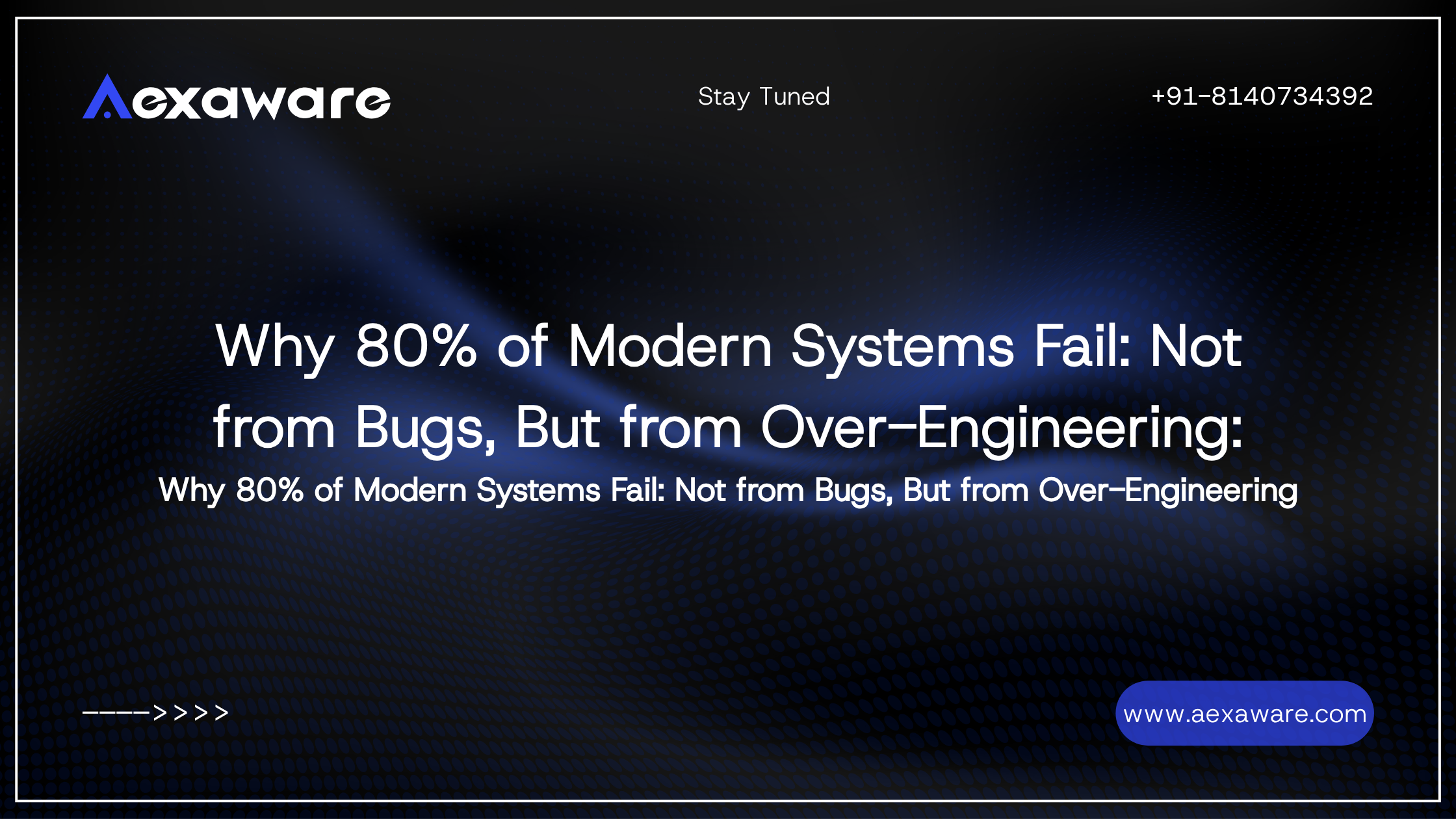Modern products rarely collapse because the code “doesn’t work.” They slow, stall, and sink because teams build more system than the business needs. That’s why Why 80% of Modern Systems Fail: Not from Bugs, But from Over Engineering matters: complexity taxes every release, every hire, and every roadmap decision.
At Aexaware Infotech, we help startups and enterprises ship simple, scalable software across web, mobile, AI, and DevOps. We’ve learned that reliability follows simplicity. Google’s SRE playbook puts it plainly: simplicity is a prerequisite to reliability.
The real failure mode: engineering theater, not broken code
We’ve reviewed systems where APIs responded, tests passed, and dashboards stayed green yet product velocity fell. Why? Teams added gateways, routers, decorators, queues, and wrappers to handle 200 daily events that a single endpoint could process. Features then took months, not weeks. Onboarding stretched from days to quarters.
This isn’t sloppiness. It’s theater: micro-patterns, generic handlers, and “future-proof” abstractions that solve problems you don’t have. In project terms, it’s gold-plating adding unasked-for features that add risk, cost, and delay. PMBOK and PRINCE2 both warn against it.
Why teams over-engineer
- Incentives. Clever architectures win reviews; boring ones ship value.
- Premature optimization. “What if we need to swap databases?” You probably won’t.
- Pattern fever. Strategy/factory/mediator everywhere, even for three business rules.
- Abstraction creep. Wrapping every library “for flexibility” hides power and adds code.
- Fear of refactoring. We design for hypothetical futures instead of today’s reality.
The Standish CHAOS research reminds us that complexity kills outcomes: many IT projects are challenged or fail outright, especially as scope grows. Keeping the solution small and clear dramatically improves the odds.
Proof in the wild: simplicity scales
A favorite example: Prime Video’s team simplified a distributed, serverless monitoring pipeline into a single process for their use case. The result? Over 90% lower infrastructure cost and better scaling. Their takeaway was pragmatic not anti-cloud, not anti-services just “right tool, right size.”
Industry leaders also advise starting small. Martin Fowler’s MonolithFirst argues that many products should begin as a modular monolith, then extract services when there’s real pressure to do so. It reduces cognitive load and makes refactors surgical, not heroic.
Quick self-test: are you over-engineering?
- You can’t sketch the architecture on a whiteboard in five minutes.
- Every simple change touches 4+ services and two message buses.
- New engineers need months to ship their first feature.
- You wrap core SDKs “just in case,” and lose type safety and IDE help.
- Conditionals become strategies; simple flows become orchestration frameworks.
If you nodded more than twice, you’re paying a complexity tax in cycle time, morale, and money. Google SRE recommends aligning engineering to user needs and SLOs to curb that tax.
What to do instead (the Aexaware way)
1) Start from outcomes, not architecture.
Define the user journey, the SLOs, and the smallest deployable change. Let SLOs, not hypotheticals, decide where you need complexity.
2) Monolith first, modular always.
Prefer a clear, modular monolith with bounded contexts. Extract services only when scaling, team boundaries, or SLOs demand it.
3) YAGNI as a rule.
Don’t build for channels, tenants, or regions you don’t serve yet. Add them when data shows the need. (That’s the essence of XP’s “You Aren’t Gonna Need It.”)
4) Keep dependencies honest.
Use platform clients directly unless the wrapper adds real value (observability, retries, circuit breaking). Wrapping everything creates leaky, brittle layers.
5) Make decisions transparent.
Record Architecture Decision Records (ADRs). Revisit them quarterly against SLOs, cost, and delivery speed.
6) Measure complexity.
Track lead time, change failure rate, MTTR, and infra spend per transaction. When any trend worsens, simplify before you scale.
7) Refactor in the open.
Budget lightweight refactors every sprint. When patterns emerge, extract them then not before.
How Aexaware helps reduce complexity across web, mobile, AI, and DevOps
- Lean architecture reviews. We cut ceremony and focus on user-level SLOs, cost, and maintainability.
- Web & mobile delivery. Modular monoliths or just-enough services with clean APIs and strong product analytics.
- AI with purpose. We add AI where it moves a KPI search, recommendations, summarization not as a science project.
- DevOps & platform engineering. Golden paths, CI/CD, IaC, and observability that simplify deployment. No yak-shaving.
- Cost & reliability tuning. Right-size infrastructure, reduce chatty networks, and remove redundant hops like the Prime Video lesson.
Our goal is not to ship cleverness. It’s to ship clarity software that teams understand and users trust.
Real-world patterns we purposely avoid
- Generic pipelines for simple CRUD. Ceremony slows teams.
- Frameworks for imaginary channels. Email today doesn’t need a cross-channel orchestrator.
- Strategy pattern everywhere. Three rules don’t need six classes.
- “Swappable” database layers. Migrations require explicit, domain-aware work wrappers don’t change that.
These anti-patterns map directly to gold-plating and scope drift in project management. They feel safe but add risk.
The impact: faster delivery, lower risk, happier teams
When you minimize indirection, three good things happen:
- Speed. Smaller blast radius, shorter lead time.
- Reliability. Fewer moving parts; easier failure modes. (Again: simplicity → reliability.)
- Cost. Less orchestration, less idle compute, less over-provisioning. (Real teams report dramatic savings after simplifying.)
This is how products escape rewrite cycles and keep momentum by building only what the business needs now and earning the right to add complexity later.
Summary & next step
Why 80% of Modern Systems Fail: Not from Bugs, But from Over Engineering is a reminder to choose clarity over cleverness. Start small. Prove value. Let real usage shape architecture. Use microservices, queues, or advanced ML only when they solve a proven constraint.
If you want a second set of eyes or a partner to deliver Aexaware Infotech can help you design the simplest thing that scales. Let’s review your stack, reduce complexity, and ship faster with confidence.
Ready to build scalable, simple software?
Connect with Aexaware to plan your next release the right way.




